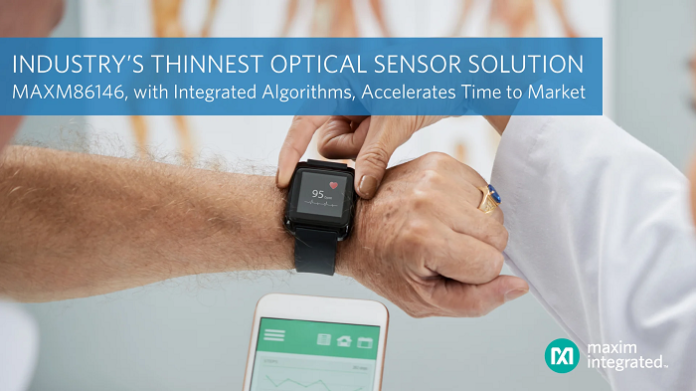By Gina Roos, editor-in-chief
Maxim Integrated Products, Inc. has claimed the industry’s thinnest dual-photodetector optical sensor solution for wearable health and fitness products. The MAXM86146 optical sensor is a turnkey drop-in module that includes built-in algorithms for heart-rate and oxygen-saturation (SpO2 ) monitoring, as well as advanced activity classification. The small size in combination with its ease of design enables biosensing features in less space with a faster development time for continuous health-monitoring devices.

Maxim’s vision for the future is personalized connected health care that encompasses remote monitoring solutions to either diagnose or continuously monitor a chronic disease. The current environment is driving a shift in mindset around prevention and early detection and taking charge of an individual’s overall health, said Andrew Baker, managing director, Industrial and Healthcare Business Unit at Maxim Integrated, in a webinar .
“The revolution in health care for remote patient monitoring is really accelerating due to the unprecedented times that we find ourselves in, and access to health-care insights is enabling medical professionals as well as individuals to more closely manage preventative care needs as well as manage chronic diseases,” he added.
“So we’re really moving toward what is termed as ‘actionable insights,’” he said. “In the old days, we were talking about the quantified self. For example, counting steps [or] monitoring your heart rate, whether that’s during exercise or resting, but really, there was no real action or insight given into your overall health and wellness.”
The solution
“In today’s environment, people want solutions accelerated; the FDA is providing accelerated approval for some types of devices in the case of the [Covid-19] pandemic, but you still need the tools to enable it,” said Baker. “The first thing is to make sure that you’re measuring things that are at clinical grade, so you need to provide sensing solutions that are clinical-grade and that could be approved by the relevant regulatory bodies.”
The other critical factor is that these devices need to be small and offer space savings, he said. “More and more devices are shrinking, getting more convenient to use, and are easier to deploy, and as they get smaller, generally speaking, there are cost savings to be added as well.”
It also requires advanced algorithms and an optimized optical-mechanical design for cleaner signals, he added.
Maxim’s sensor solution meets those requirements. The optical sensor module combines two photodiodes, an optical AFE, and a microcontroller with built-in algorithms (activity classification, heart rate, SpO2 ) in a 0.88-mm package that is 45% thinner than a discrete solution. The ready-to-use biosensing algorithms measure vital signs to the strictest medical standards.
The microcontroller acts as a sensor hub that runs the sensing algorithms to enable the measurement of critical vital signs such as activity classification, optical heart rate, and blood oxygen saturation.
The drop-in module cuts development time by up to six months, according to Maxim, and gives designers extra time and space to focus on expanded functionality thanks to the “ready to go” algorithms.
The major value-add is the ability to securely download the Maxim algorithms seamlessly to implement the optical sensing solutions, said Baker. One of the reasons why it accelerates time to market is because of the built-in downloadable ready-to-go optical algorithms “that really bring out the signal from the noise,” he added.
Baker believes there is “overwhelming support for remote patient monitoring” and that the development of enabling solutions for remote patient monitoring has changed forever due to the Covid-19 pandemic.
However, he also noted that these new solutions are not only for today’s Covid-19 pandemic but are enabling technologies for longer-term remote monitoring trends that include enabling better predictive and preventive solutions as well as health-care and chronic disease management.
The MAXM86146CFU+ is available at the company’s website for $5.84 (1,000-up, FOB USA) and through its authorized distributors. The MAXM86146EVSYS# evaluation kit is priced at $150.
Advertisement
Learn more about Electronic Products MagazineMaxim Integrated





